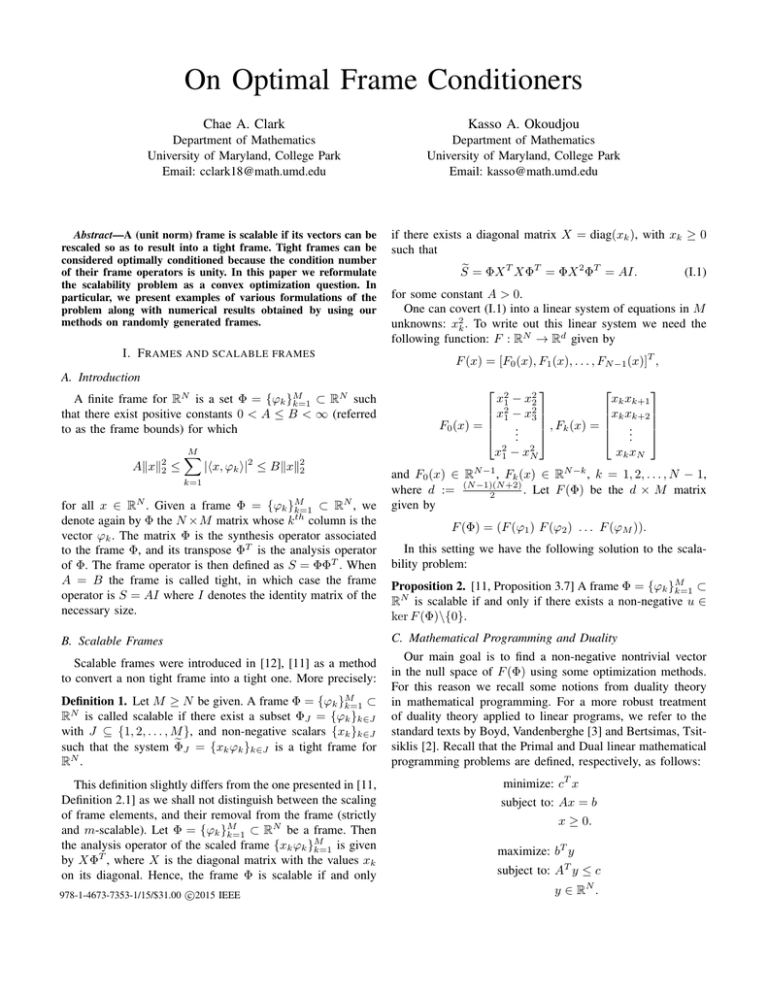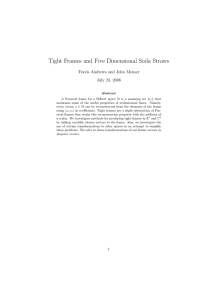On Optimal Frame Conditioners Chae A. Clark Kasso A. Okoudjou
advertisement

On Optimal Frame Conditioners
Chae A. Clark
Kasso A. Okoudjou
Department of Mathematics
University of Maryland, College Park
Email: cclark18@math.umd.edu
Department of Mathematics
University of Maryland, College Park
Email: kasso@math.umd.edu
Abstract—A (unit norm) frame is scalable if its vectors can be
rescaled so as to result into a tight frame. Tight frames can be
considered optimally conditioned because the condition number
of their frame operators is unity. In this paper we reformulate
the scalability problem as a convex optimization question. In
particular, we present examples of various formulations of the
problem along with numerical results obtained by using our
methods on randomly generated frames.
I. F RAMES AND SCALABLE FRAMES
if there exists a diagonal matrix X = diag(xk ), with xk ≥ 0
such that
Se = ΦX T XΦT = ΦX 2 ΦT = AI.
(I.1)
for some constant A > 0.
One can covert (I.1) into a linear system of equations in M
unknowns: x2k . To write out this linear system we need the
following function: F : RN → Rd given by
F (x) = [F0 (x), F1 (x), . . . , FN −1 (x)]T ,
A. Introduction
N
A finite frame for RN is a set Φ = {ϕk }M
such
k=1 ⊂ R
that there exist positive constants 0 < A ≤ B < ∞ (referred
to as the frame bounds) for which
Akxk22
≤
M
X
2
|hx, ϕk i| ≤
Bkxk22
k=1
N
for all x ∈ RN . Given a frame Φ = {ϕk }M
k=1 ⊂ R , we
th
denote again by Φ the N ×M matrix whose k column is the
vector ϕk . The matrix Φ is the synthesis operator associated
to the frame Φ, and its transpose ΦT is the analysis operator
of Φ. The frame operator is then defined as S = ΦΦT . When
A = B the frame is called tight, in which case the frame
operator is S = AI where I denotes the identity matrix of the
necessary size.
B. Scalable Frames
Scalable frames were introduced in [12], [11] as a method
to convert a non tight frame into a tight one. More precisely:
Definition 1. Let M ≥ N be given. A frame Φ = {ϕk }M
k=1 ⊂
RN is called scalable if there exist a subset ΦJ = {ϕk }k∈J
with J ⊆ {1, 2, . . . , M }, and non-negative scalars {xk }k∈J
e J = {xk ϕk }k∈J is a tight frame for
such that the system Φ
RN .
This definition slightly differs from the one presented in [11,
Definition 2.1] as we shall not distinguish between the scaling
of frame elements, and their removal from the frame (strictly
N
and m-scalable). Let Φ = {ϕk }M
be a frame. Then
k=1 ⊂ R
the analysis operator of the scaled frame {xk ϕk }M
k=1 is given
by XΦT , where X is the diagonal matrix with the values xk
on its diagonal. Hence, the frame Φ is scalable if and only
c
978-1-4673-7353-1/15/$31.00 2015
IEEE
x21 − x22
xk xk+1
x21 − x23
xk xk+2
F0 (x) =
, Fk (x) = ..
..
.
.
x21 − x2N
xk xN
and F0 (x) ∈ RN −1 , Fk (x) ∈ RN −k , k = 1, 2, . . . , N − 1,
+2)
where d := (N −1)(N
. Let F (Φ) be the d × M matrix
2
given by
F (Φ) = (F (ϕ1 ) F (ϕ2 ) . . . F (ϕM )).
In this setting we have the following solution to the scalability problem:
Proposition 2. [11, Proposition 3.7] A frame Φ = {ϕk }M
k=1 ⊂
RN is scalable if and only if there exists a non-negative u ∈
ker F (Φ)\{0}.
C. Mathematical Programming and Duality
Our main goal is to find a non-negative nontrivial vector
in the null space of F (Φ) using some optimization methods.
For this reason we recall some notions from duality theory
in mathematical programming. For a more robust treatment
of duality theory applied to linear programs, we refer to the
standard texts by Boyd, Vandenberghe [3] and Bertsimas, Tsitsiklis [2]. Recall that the Primal and Dual linear mathematical
programming problems are defined, respectively, as follows:
minimize: cT x
subject to: Ax = b
x ≥ 0.
maximize: bT y
subject to: AT y ≤ c
y ∈ RN .
Theorem 3 (Strong Duality). If either the primal or dual
problem has a finite optimal value, then so does the other.
The optimal values coincide, and optimal solutions to both
the primal and dual problems exist.
Theorem 4 (Complimentary Slackness). Let x∗ and y ∗ be
feasible solutions to the primal and dual problems respectively.
Let A be an N by M matrix, where Aj denotes the jth column
and ai denotes the ith row of A. Then x∗ and y ∗ are optimal
solutions to their respective problems if and only if
Theorem 5 is very general in that the convex objective
function f can be chosen so as the resulting frame has
some desirable properties. We now consider certain interesting
examples of objective functions f . These examples can be
related to the sparsity (or lack thereof) of the desired solution.
Using a linear objective function promotes sparsity, while
barrier objectives promote dense solutions (small number of
zero elements in u).
A. Linear Program Formulation
Assume that the objective function in (II.1) is given by
f (u) := aT u for some coefficient vector a ∈ RM \{0}. Our
program P now becomes
yi (ai · x − bi ) = 0 for all i = 1, . . . , N,
and
xi (cj − y T Aj ) = 0 for all j = 1, . . . , M.
II. R EFORMULATION OF THE SCALABILITY PROBLEM AS
AN OPTIMIZATION PROBLEM
(II.2)
subject to: F (Φ)u = 0
This section establishes the equivalence of generating a
scaling matrix X and solving an optimization problem of
a generic convex objective function. More specifically, we
shall phrase the scalability problem as a linear and convex
programming problem.
First consider the sets S1 and S2 given by
S1 := {u ∈ RM | F (Φ)u = 0 , u ≥ 0 , u 6= 0},
and
S2 := {v ∈ RM | F (Φ)v = 0 , v ≥ 0 , kvk1 = 1}.
S1 is a subset of the null space of F (Φ), and each u ∈ S1 is
associated a scaling matrix Xu , defined as
√
ui
if i = j
Xu := (Xij )u =
0
otherwise.
1
S2 ⊂ S1 ∩ B`1 where B`1 is the unit ball under the ` norm.
N
We observe that a frame Φ = {ϕk }M
is scalable
k=1 ⊂ R
if and only if there exists a scaling matrix Xu with u ∈ S1 .
Consequently, one can associate to Xu a scaling matrix Xv
with v ∈ S2 . The normalized set S2 ensures that the constraints
in the optimization problems to be presented are convex.
N
Theorem 5. Let Φ = {ϕk }M
be a frame, and let
k=1 ⊂ R
f : RM → R be a convex function. Then the program
(P) minimize: f (u)
(P1 ) minimize: aT u
(II.1)
kuk1 = 1
u ≥ 0.
Choosing the coefficients a independently of the variables u,
results in a linear program. For example, the choice ai = 1 for
all i result in a program to minimize the `1 norm of u. Another,
more useful choice of coefficients is ai = kF (ϕ1i )k2 . Under this
regime, a higher weight is given to the frame elements with
smaller norm (which further encourages sparsity).
One of the advantages of linear programs is that they
admit a strong dual formulation. To the primal problem P1
corresponds the following dual problem P2 .
N
Proposition 6. Let Φ = {ϕk }M
be a frame. The
k=1 ⊂ R
program
(P2 ) maximize: w
v
subject to: [F (Φ) 1]
≤a
w
T
w ∈ R , v ∈ Rd
is the strong dual of P1 .
Proof. This result follows exactly from the construction of
dual formulations for linear programs. The primal problem
can be formulated as follows:
minimize:
subject to: F (Φ)u = 0
M
X
u≥0
ui = 1
i=1
has a solution if and only if the frame Φ is scalable.
Proof. Any feasible solution u∗ of P is contained in the set
S2 , which itself is contained in S1 , and thus corresponds to a
scaling matrix Xu .
Conversely, any u ∈ S1 can be mapped to a v ∈ S2 by
appropriate scaling factor. This provides an initial feasible
solution to P, and as f is convex and the constraints are convex
and bounded, there must exist a minimizer of P.
ai ui
i=1
subject to: F (Φ)u = 0
kuk1 = 1
M
X
u ≥ 0.
The strong dual of this problem is:
maximize: w
v
subject to: [F (Φ) 1]
≤ a.
w
T
Numerical optimization schemes, in many cases, consist of
a search for an initial feasible solution, and then a search for an
optimal solution. In analyzing the linear program formulation
P1 , we notice that we either have an optimal solution or the
problem is infeasible, but there is no case when the problem
is unbounded (due to the bounding constraint kuk1 = 1).
The dual problem has the property that it either has an optimal solution, or is unbounded (from duality). Consequently,
for any frame Φ, w = min{a} and v = 0 is always a feasible
solution to the dual problem. This removes the requirement
that an initial solution be found [2].
with positive elements if and only if the solution produced by
solving this problem has positive elements.
Proof. To show this, we shall rewrite this problem as a linear
program.
maximize: t
subject to: F (Φ)u = 0
M
X
t ≤ ui
t > 0 , u ≥ 0.
A sparse solution to the linear program produces a frame
in which the frame elements corresponding to the zero coefficients are removed. In contrast, one may wish to have a full
solution, that is, one may want to retain all of, or most of, the
frame vectors. To enforce this property, we use two types of
barrier objective functions.
N
Proposition 7. Let Φ = {ϕk }M
be a frame, and
k=1 ⊂ R
define 0 ≤ 1. If the problem
M
X
ln(ui + )
(II.3)
i=1
subject to: F (Φ)u = 0
kuk1 = 1
u ≥ 0.
has a feasible solution u∗ with a finite objective function value,
then the frame Φ is scalable, and the scaling matrix X is a
diagonal operator where the elements are the square-roots of
the feasible solution u∗ . Moreover, for = 0, if a solution u∗
exists, all elements of u∗ are strictly positive.
Here, t is an auxiliary variable, taken to be the minimum
element of u. This linear program can be solved to optimality.
Moreover, as this problem is convex, the optimum achieved
is global. If the objective function at optimality has a value
of 0, then there can exist no solution with all positive coefficients.
III. AUGMENTED L AGRANGIAN M ETHODS
To efficiently solve these convex formulations, we employ
the method of augmented Lagrangians. Utilizing this method
is more a personal choice, as a multitude of first-order methods
exist. The augmented Lagrangian is chosen due to its flexibility. Sparse solutions can be induced through thresholding, and
dense solutions can be induced through choice of objective
function. As an example, consider the problem (P), with
the objective function f (u) := kuk2`2 , Rewriting norms as
matrix/vector products we are interested in
minimize: uT Iu
subject to: F (Φ)u = 0
1T u = 1
∗
Proof. Assume u is a feasible solution to (II.3) with 0 <
1 and the objective function finite. Then from Theorem
5, we have that the frame Φ is scalable. Now assume = 0. If
one of the variables ui were zero, then the objective function
would have a value of −∞. Since we assume the function is
finite, this cannot be the case. A negative value for ui would
result in the objective function value being undefined, this also
cannot be the case due to the finite objective. Therefore, ui
must be positive for all i.
N
Proposition 8. Let Φ = {ϕk }M
be a frame. If the
k=1 ⊂ R
problem
(P4 ) maximize:
ui = 1
i=1
B. Barrier Formulations
(P3 ) maximize:
(II.5)
min {ui }
u ≥ 0.
Here, I is the M × M identity matrix. For notational convenience, we denote L and b to be
F (Φ)
0
and
1
1T
respectively. The `2 problem is now
minimize: uT Iu
subject to: Lu = b
u ≥ 0.
(II.4)
To solve this problem, the augmented Lagrangian L is formed,
has a feasible solution u∗ with a finite objective function
value, then the frame Φ is scalable, and the scaling matrix
X is a diagonal operator where the elements are the squareroots of the feasible solution u∗ . Moreover, a solution exists
λ
kLu − bk22
2
λ
= uT Iu + µT Lu − µT b + (uT LT Lu − 2uT LT b + bT b).
2
This function is minimized through satisfying the first-order
condition, ∇L = 0.
The gradient of the Lagrangian with respect to u is solved
through standard calculus-based methods. The Lagrangian
i=1,...,M
subject to: F (Φ)u = 0
kuk1 = 1
u ≥ 0.
L = uT Iu + hµ, Lu − bi +
with respect to the dual variables µ and λ is linear, which
we optimize through gradient descent. The tuning parameter
η denotes the scaling of the descent direction.
∇u L = 2Iu + LT µ + λLT Lu − λLT b.
0 = (2I + λLT L)u + LT µ − λLT b.
(2I + λLT L)u = λLT b − LT µ.
Dividing the equation by λ, we have
2
µ
I + LT L u = LT b − LT .
λ
λ
2
µ
.
I + LT L u = LT b −
λ
λ
−1
µ
2
.
u=
I + LT L
LT b −
λ
λ
The dual variables have the following gradients,
∇µ L = Lu − b.
1
∇λ L = hLu − b, Lu − bi.
2
IV. N UMERICAL E XAMPLES
The following numerical tests are intended to illustrate our
methods by scaling frames generated from Gaussian distributions. In particular, throughout this section, we identify random
frames Φ with full-rank random N × M matrices whose
elements are i.i.d., drawn from a Gaussian distribution with
zero mean and unit variance. These random frames are not
tight, but they are not badly conditioned. This follows from the
incoherence between Gaussian frame elements [8] and results
on singular/eigen-values by Edelman [9]. Future work will
involve specific subclasses of frames to better characterize the
space.
The first set of figures are intended to give a representation
of how the scaling affects frames in R2 . A number of Gaussian
random frames are generated in MatLab, and a scaling process
is performed by solving one of the optimization problems
above (the specific program used is noted under the figures).
The Gaussian frame is first normalized to be on the unit circle.
The (blue\circle) vectors correspond to the original frame
vectors, and the (red\triangle) vectors represent the resulting
scaled frame.
And forming the gradient descent algorithm with η, results in
Algorithm 1 Gradient Descent w.r.t. µ
while not converged do
µk+1 ← µk − η · (Lu − b)
end while
Algorithm 2 Gradient Descent w.r.t. λ
while not converged do
η
λk+1 ← λk − · hLu − b, Lu − bi
2
end while
Fig. IV.1. These examples display the effect of scaling frames in R2 . The
frames are sized M = 7 (Left) and M = 30 (Right), and were scaled using
the Augmented Lagrangian Scheme. The left figure shows that scalings favor
isolated frame elements. The right figure shows that as the frame elements
fill the space, the scalings become more normalized.
Lastly, to retain the non-negativity of the solution, we
project the current solution onto R+ . This is accomplished by
setting any negative values in the solution to 0 (thresholding).
We shall denote this P+ (·). Forming the full augmented
Lagrangian scheme, we now have the complete `2 derivation.
Algorithm 3 Full Augmented Lagrangian Scheme (`2 )
while not converged do
−1
2
µk
vk+1 ←
I + LT L
LT b −
λk
λk
uk+1 ← P+ (vk+1 )
µk+1 ← µk − η · (Luk+1 − b)
η
λk+1 ← λk − · hLuk+1 − b, Luk+1 − bi
2
end while
Fig. IV.2. These examples illustrate scalable frames with a small number of
positive weights. The frames are sized M = 7 (Left) and M = 30 (Right),
and were scaled using linear programming formulation P1 (more specifically,
the Simplex algorithm). These two example show that for frames of low (Left)
and high (Right) redundancy, sparse solutions are possible and seemingly
unrelated to the number of frame elements.
A Gaussian frame is generated of the required sizes and a
scaling is attempted. This is performed over a hundred trials,
and the proportion of frames that were scalable was retained.
For each N , a plot of the proportions across frame size M
is presented. To display these plots in a single figure, the
independent variable M is scaled to lie in the range (0,1).
1
Fig. IV.3. These frames show full scaling results from the log-barrier method.
The frames are sized M = 15 (Left) and M = 20 (Right), and as was
mentioned in figure IV.1, the scalings favor isolated frame elements.
N \M
2
3
4
5
3
3
-
Sparsity Test Results [Gaussian Frames]
4 5
10
20
30
40
3 3
3
3
3
3
6.01
6
6
6
10.1
10.12
10.1
10
15.08
15.12
15.11
TABLE IV.1
50
3
6
10
15.05
T HE AVERAGE NUMBER OF FRAME ELEMENTS RETAINED AFTER SCALING
USING THE LINEAR PROGRAM FORMULATION . E NTRIES WITH A “-” IMPLY
THAT THE PROPORTION OF SCALABLE FRAMES IN THE SPACE IS TOO
SMALL FOR PRACTICAL TESTING .
N \M
10
15
20
25
Sparsity Test Results [Gaussian Frames]
150
200
250
500
750
56.06 56.02
55.72
55.57
55.66
123.76
123.98
123.37
217.6
218.6
TABLE IV.2
1000
55.6
123.1
219.45
338.67
T HE AVERAGE NUMBER OF FRAME ELEMENTS RETAINED AFTER SCALING
USING THE LINEAR PROGRAM FORMULATION . E NTRIES WITH A “-” IMPLY
THAT THE PROPORTION OF SCALABLE FRAMES IN THE SPACE IS TOO
SMALL FOR PRACTICAL TESTING .
Observe that the results presented in tables IV.1 and IV.2
show an interesting trend. The average number of elements
required to scale a frame appears to be d + 1 = N (N2+1) . The
linear system being solved during the Simplex method has
dimensions (d + 1) × M , and attempts to find a non-negative
solution in RM . It seems unlikely that this solution can be
found using less than d + 1 frame elements.
The final test presents the proportion of scalable Gaussian
frames of a given size over 100 trials. For testing, the number
of frame vectors is determined by the dimension of the
underlying space. For a frame in RN , the number of frame
elements used ranges from N + 1 to 4N 2 (e.g. for N = 2, the
number of frame elements range from M = 3 to M = 16).
0.8
Scalability Proportions
The next tables illustrate the sparsity that is achieved in
scaling a frame. That is, using the linear program, we present
the average number of non-zero frame elements retained
over 100 trials. Our data seem to suggest the existence of
a minimum number of frame elements required to perform
a scaling, and this number seems to depend only on the
dimension of the underlying space. This phenomenon should
be compared to the estimates on the probability that a frame of
M vectors in RN is scalable that were obtained in [7, Theorem
4.9].
0.9
0.7
0.6
0.5
0.4
0.3
0.2
0.1
0
0
0.2
0.4
0.6
Frame Elements
0.8
1
Fig. IV.4. Each graph in this figure gives the proportion of scalable frames
generated after 100 trials. The sizes of the frames range from N + 1 to 4N 2 .
To fit the graphs in a single figure, the range of each figure is scaled to be from
0 to 1. The frame dimensions are N = 2 (Blue\Circle), N = 3 (Red\Star),
N = 4 (Green\Triangle), N = 5 (Cyan\Box), and N = 10 (Magenta\x).
V. ACKNOWLEDGMENTS
Chae Clark would like to thank the Norbert Wiener Center
for Harmonic Analysis and Applications for its support during
this research. Kasso Okoudjou was partially supported by a
RASA from the Graduate School of UMCP and by a grant
from the Simons Foundation (#319197 to Kasso Okoudjou).
R EFERENCES
[1] F. Bach, R. Jenatton, J. Mairal, and G. Obozinski. Convex optimization
with sparsity-inducing norms. Optimization for Machine Learning, pages
19–53, 2011.
[2] D. Bertsimas and J. Tsitsiklis. Introduction to linear optimization. 1997.
[3] S. P. Boyd and L. V. Convex optimization. Cambridge university press,
2004.
[4] E. J. Candes and T. Tao. Decoding by linear programming. Information
Theory, IEEE Transactions on, 51(12):4203–4215, 2005.
[5] P. Casazza and G. Kutyniok. Finite frames. Springer, 2012.
[6] S. S. Chen, D. Donoho, and M. Saunders. Atomic decomposition by
basis pursuit. SIAM journal on scientific computing, 20(1):33–61, 1998.
[7] X. Chen, G. Kutyniok, K. Okoudjou, F. Philipp, and R. Wang. Measures
of scalability. arXiv preprint arXiv:1406.2137, 2014.
[8] David L Donoho and Xiaoming Huo. Uncertainty principles and ideal
atomic decomposition. Information Theory, IEEE Transactions on,
47(7):2845–2862, 2001.
[9] Alan Edelman. Eigenvalues and condition numbers of random matrices.
SIAM Journal on Matrix Analysis and Applications, 9(4):543–560, 1988.
[10] G. Golub and C. V. L. Matrix computations, volume 3. JHU Press,
2012.
[11] G. Kutyniok, K. Okoudjou, and F. Philipp. Scalable Frames and Convex
Geometry. Contemp. Math. 626 (2014), 19-32.
[12] G. Kutyniok, K. Okoudjou, F. Philipp, and E. Tuley. Scalable frames.
Linear Algebra and its Applications, 438(5):2225 – 2238, 2013.
[13] WR Madych. On underdetermined systems. In Numerical Linear
Algebra, Digital Signal Processing and Parallel Algorithms, pages 541–
545. Springer, 1991.





